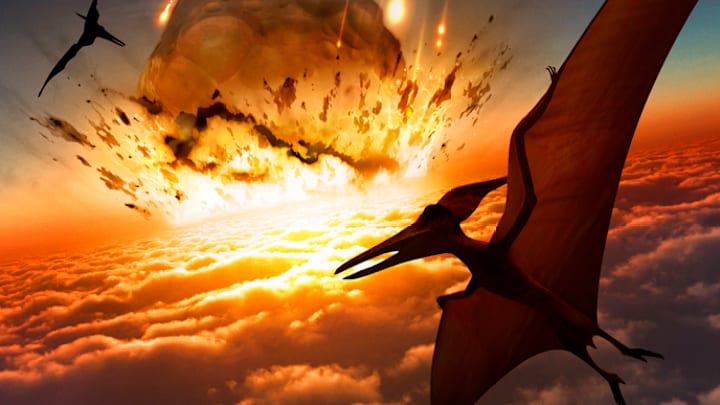Some 66 million years ago, an asteroid with a diameter of about six miles crashed off the coast of the Yucatán Peninsula in Mexico. The Chicxulub asteroid—named for the shoreside town near the underwater impact site—unleashed mega-tsunamis across the ocean and earthquakes throughout the North American continent [PDF].
Over 27 trillion tons of material was launched into the air, much of it hot dust and ash. Some debris briefly escaped the planet and then burned upon reentry, creating searing fireballs from the sky. Scientists think the resulting wildfires destroyed about 70 percent of Earth’s forests. Sulfur released into the air caused worldwide temperatures to plummet. Dust from the impact lingered in the air for a long period of time [PDF], blocking out sunlight, mass-killing plants, and cutting off food chains at their start.
Sixty percent of species on Earth, including all non-avian dinosaurs, went extinct. The Mesozoic Era was over.
Now, using isotope samples from geological sites thought to have been bathed in this atmospheric impact, researchers suggest that the Chicxulub asteroid came from the outer solar system.
Primordial Ingredients
Scientists think that the impact of the Chicxulub asteroid was so great that geological formations, in the process of being shaped when it struck, have a distinct chemical signature: a singular band of rock unusually thick with iridium, a chemical element common in asteroids that the impact spread across the atmosphere. These Cretaceous–Paleogene (K-Pg) boundary sites include Steven’s Klint, a group of white cliffs on a Danish island; and a cave near Caravaca, Spain.
For the recent research, published in the journal Science, geochemist Mario Fischer-Gödde led a team that found isotope signatures from these two K-Pg boundary sites matched those of two carbonaceous meteorites, a type that rarely falls to Earth. Some of the oldest objects in the solar system, these meteorites are made of primordial materials with a composite that indicates they were formed far from the sun, past the orbit of Jupiter. Only 3 percent of the meteorites that ever reach our planet are carbonaceous.
The group did not find the same match when they compared the K-Pg site isotope signatures to those of other asteroid impact sites or to samples of spherule layers (spherical particles that form after an impact) from within the Earth.
Blowing Up a Volcanic Hypothesis
The first comparison is significant because these other impact sites were probably from siliceous asteroids, a kind found in the inner asteroid belt, between the orbits of Mars and Jupiter. Chemically, these are more pedestrian and not dissimilar from Earth rocks.
The second comparison is significant because an alternative hypothesis for the mass extinction event that killed dinosaurs and caused K-Pg boundaries points to volcanic eruptions in what is now Deccan Trap, India, as the source. If this was the case, the researchers theorize, the isotope signatures of the K-Pg boundaries would match that of spherule layers of Earth, which were shot up by the volcano. (The eruptions could have been a contributing factor to the extinction.)
Also, the signatures do not resemble those of comets, icy objects whose unique trajectories are caused when they passes close to a sun, releasing gases.
Asteroids, like planets, usually follow predictable orbits around the sun, but the gravitational pull of another object, like a planet, can cause them to go off course—which apparently happened with world-changing impact 66 million years ago.
Read More Amazing Stories About Dinosaurs:
